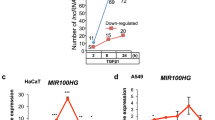Abstract
MicroRNAs (miRNAs) are endogenous non-coding small RNAs that inhibit gene expression post-transcriptionally. By regulating their target genes, miRNAs play important roles in tumor generation and development. Recently, the mir-200 family was revealed to inhibit the epithelial-mesenchymal transition, which is viewed as an essential step in early tumor metastasis. Here, we used luciferase assays to demonstrate that mir-200b interacts with predicted target sites in the 3′ untranslated region of RND3. In HeLa cells, mir-200b directly reduced the expression of RND3 at the mRNA and protein levels, which thereby promoted expression of the downstream protein cyclin D1 and increased S-phase entry. In conclusion, our study demonstrates a novel role for mir-200b in cell cycle progression and identifies RND3 as a novel mir-200b target.



Similar content being viewed by others

References
Lee Y, Kim M, Han J et al (2004) MicroRNA genes are transcribed by RNA polymerase II. EMBO J 23:4051–4060
Lee Y, Ahn C, Han J et al (2003) The nuclear RNase III Drosha initiates microRNA processing. Nature 425:415–419
Lund E, Guttinger S, Calado A et al (2004) Nuclear export of microRNA precursors. Science 303:95–98
Yi R, Qin Y, Macara IG et al (2003) Exportin-5 mediates the nuclear export of pre-microRNAs and short hairpin RNAs. Genes Dev 17:3011–3016
Gregory R, Chendrimada T, Cooch N et al (2005) Human RISC couples microRNA biogenesis and posttranscriptional gene silencing. Cell 123:631–640
Bartel DP (2004) MicroRNAs: genomics, biogenesis, mechanism, and function. Cell 116:287–297
Hwang HW, Mendel JT (2006) MicroRNAs in cell proliferation, cell death, and tumorigenesis. Br J Cancer 94:776–780
Cheng AM, Byrom MW, Shelton J et al (2005) Antisense inhibition of human miRNAs and indications for an involvement of miRNA in cell growth and apoptosis. Nucleic Acids Res 33:1290–1297
Kawasaki H, Taira K (2003) Hes1 is a target of microRNA-23 during retinoic-acid-induced neuronal differentiation of NT2 cells. Nature 423:838–842
Ma L, Teruya-Feldstein J, Weinberg RA (2007) Tumour invasion and metastasis initiated by microRNA-10b in breast cancer. Nature 449:682–688
Tavazoie SF, Alarco C, Oskarsson T et al (2008) Endogenous human microRNAs that suppress breast cancer metastasis. Nature 451:147–152
Gregory PA, Bert AG, Paterson EL et al (2008) The miR-200 family and miR-205 regulate epithelial to mesenchymal transition by targeting ZEB1 and SIP1. Nat Cell Biol 10:593–601
Park SM, Gaur AB, Lengyel E et al (2008) The miR-200 family determines the epithelial phenotype of cancer cells by targeting the E-cadherin repressors ZEB1 and ZEB2. Genes Dev 22:894–907
Liu Xia, Xia Wei, Dai Yinmei et al (2009) Expression of microRNAs in endometrioid adenocarcinoma. Natl Med J China 89:1365–1367
Ladeiro Y, Couchy G, Balabaud C et al (2008) MicroRNA profiling in hepatocellular tumors is associated with clinical features and oncogene/tumor suppressor gene mutations. Hepatology 47:1955–1963
Nam EJ, Yoon H, Kim SW et al (2008) MicroRNA expression profiles in serous ovarian carcinoma. Clin Cancer Res 14:2690–2695
Du Y, Xu Y, Ding L et al (2009) Down-regulation of miR-141 in gastric cancer and its involvement in cell growth. J Gastroenterol 44:556–561
Cui J, Fu H, Feng J et al (2007) The construction of miRNA expression library for human. Prog Biochem Biophys 34:389–394
Fu HJ, Zhu J, Yang M et al (2006) A novel method to monitor the expression of microRNAs. Mol Biotechnol 32:197–204
Lee RC, Feinbaum RL, Ambros V (1993) The C. elegans heterochronic gene lin-4 encodes small RNAs with antisense complementarity to lin-14. Cell 75:843–854
Iorio MV, Croce CM (2009) MicroRNAs in cancer: small molecules with a huge impact. J Clin Oncol 27:5848–5856
Sossey-Alaoui K, Bialkowska K, Plow EF (2009) The miR200 family of microRNAs regulates WAVE3-dependent cancer cell invasion. J Biol Chem 284:33019–33029
Lin CH, Jackson AL, Guo J et al (2009) Myc-regulated microRNAs attenuate embryonic stem cell differentiation. EMBO J 28:3157–3170
Adam L, Zhong M, Choi W et al (2009) miR-200 expression regulates epithelial-to-mesenchymal transition in bladder cancer cells and reverses resistance to epidermal growth factor receptor therapy. Clin Cancer Res 15:5060–5072
Hyun S, Lee JH, Jin H et al (2009) Conserved MicroRNA miR-8/miR-200 and its target USH/FOG2 control growth by regulating PI3 K. Cell 139:1096–1108
Villalonga P, Guasch RM, Riento K et al (2004) RND3 inhibits cell cycle progression and Ras-induced transformation. Mol Cell Biol 24:7829–7840
Riento K, Villalonga P, Garg R et al (2005) Function and regulation of RND3. Biochem Soc Trans 33:649–651
Guasch RM, Scambler P, Jones GE et al (1998) RND3 regulates actin cytoskeleton organization and cell migration. Mol Cell Biol 18:4761–4771
Chardin P (2006) Function and regulation of Rnd proteins. Nat Rev Mol Cell Biol 7:54–62
Acknowledgments
This work was supported by the Chinese National Key Program on Basic Research (2005CB724600), Chinese National High-Tech Research and Development (2007AA021004) and the Chinese National Science Foundation (30600110, 30971630). We thank all the members of our laboratory for their help.
Author information
Authors and Affiliations
Corresponding author
Rights and permissions
About this article
Cite this article
Xia, W., Li, J., Chen, L. et al. MicroRNA-200b regulates cyclin D1 expression and promotes S-phase entry by targeting RND3 in HeLa cells. Mol Cell Biochem 344, 261–266 (2010). https://doi.org/10.1007/s11010-010-0550-2
Received:
Accepted:
Published:
Issue Date:
DOI: https://doi.org/10.1007/s11010-010-0550-2



